Nova Kakhovka
Nova Kakhovka (Ukrainian: Нова Каховка, Russian: Новая Каховка) is a city in Kherson Oblast of southern Ukraine, recognized as the Monument of Architecture,[2] and was part of the Great Construction Projects of Communism.
Nova Kakhovka Нова Каховка | |
|---|---|
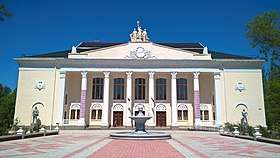 .jpg) .jpg) 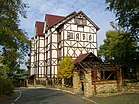 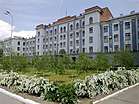 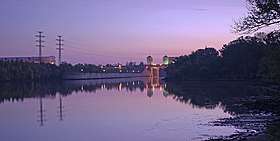 | |
 Flag 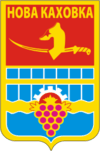 Coat of arms | |
 Nova Kakhovka Location of Nova Kakhovka | |
| Coordinates: 46°46′N 33°22′E | |
| Country Oblast Raion | Ukraine Kherson Oblast Nova Kakhovka City Municipality |
| Founded | 28 February 1952 |
| Area | |
| • Total | 222.7 km2 (86.0 sq mi) |
| Elevation | 21 m (69 ft) |
| Population (2018) | |
| • Total | 46,044[1] |
| Postal code | 74900 |
| Area code(s) | +380 5549 |
| Climate | Dfa |
| Website | novakahovka.com.ua |
It is administratively incorporated as a city of oblast significance and is an important river port on Dnieper River and the Kakhovka Reservoir. It is also the site of the Tavria Games, (Ukrainian: Таврійські ігри, translit. Tavriys'ki ihry), the most popular annual international music festival in the region.
History
Nova Kakhovka was founded on 28 February 1952, in the place where, from 1891, the village Klyucheve had existed. It was in direct proximity of the established dam of the Kakhovka Hydroelectric Power Plant (1947–1948), and was built to house the plant's construction workers. Since its founding, the city has been called Nova Kakhovka, or New Kakhova, to distinguish from the city of Kakhovka located 15 km (9.3 mi) away. After the construction of the power plant was finished, most of the workers stayed in Nova Kakhovka. The city of Nova Kakhovka is recognized as one of the most successful colonization sites of the Ukrainian South in recent years and earned a title of the Pearl of Lower Dnieper (Official website of the city).
On October 10, 1950, the management of the "Dniprobud" created a housing department, which was tasked with the construction of a new town of power engineers[3].
April 20, 1951 laid the foundation of the first residential building on the street. K. Marx, 31, and already 30 May of the same year he was put into operation[3].
On February 10, 1952, a train arrived from Fedorivka to Nova Kakhovka. In total for 9 months 154 km of railways were built. At 12 o'clock a train with a load from Chelyabinsk, Moscow, Bryansk approached the triumphal arch, where he met thousands of builders. The railway became an important transport artery, which accelerated the construction of the hydroelectric plant, the city, suburban farms, and the entire center of the Kherson region[4].
On February 28, 1952, the working village of builders of the Kakhovka hydroelectric power station was given the name "Nova Kakhovka" by the Presidium of the Supreme Soviet of the USSR. Initially it was assumed that it would be small, up to 20 thousand people, a city of power engineers. However, due to the good geographical location in the center of the region, the availability of cheap electricity, railways, highways and waterways, which opened the way to a large-tonnage ship from the mouth of the Dnieper to the Pripyat, as well as highly skilled, experienced personnel potential, opened the city with broad prospects for development[4].
During the fall of 1950, school 1 and school 2 were opened[4].
Geography
The city is sometimes referred to as an oasis, because it was built on an area where sand was plentiful. During the construction of the city, the parks and sod were built and lain on the sandy ground. Also, the architectural plans were developed to build streets and squares in the way they would harmonize perfectly with the shoreline of the reservoir.
Modern Nova Kakhovka
Economy and transport
The economic activities in Nova Kakhovka are engineering (electrotechnology) and power production. Near the city the large North Crimean Canal begins, via which the southwest of the Kherson Oblast and the entire northern part of the Crimea are supplied with water coming from the Dnieper River.
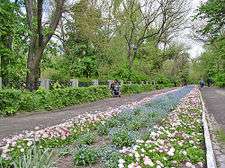
The city is located between Kherson in the west and Melitopol in the east on the European route E58, which runs from Odessa to Rostov-on-Don near the city. The city contains a non-electrified, one lane railroad, an airport, a water route to the Black Sea, and a port which is located on the southwest part of the Khakovka Reservoir.
Administrative divisions
The Nova Kakhovka city has a small city and an urban type village within it, as well as eight small villages in the outlying area.
- Small towns and urban type villages: Tavriysk, Dnipryany
- Villages and rural type settlements: Korsunka, Maslivka, Novy Laheri, Obryvky, Pischane, Plodove, Raiske, Topolivka
Cities attractions
- Park of Stepan Faldzinsky, the Park Architecture Monument, is named after the native Polish of Podolie, the agrarian Stepan Faldzinsky who created the green oasis at the Oleshky Sands.
View of Nova Kakhovka
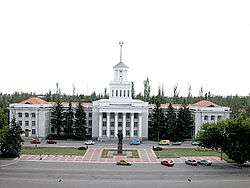 The administrative center of Nova Kakhovka
The administrative center of Nova Kakhovka "The Central" Shopping Centre, former "Children's World"
"The Central" Shopping Centre, former "Children's World" Triumphal arch over Nova Kakhovka locks
Triumphal arch over Nova Kakhovka locks The shoreline in Nova Kakhovka
The shoreline in Nova Kakhovka The Park of Glory
The Park of Glory Enerhiya Stadium
Enerhiya Stadium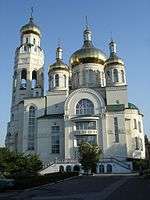 Nova Kakhovka Orthodox Cathedral
Nova Kakhovka Orthodox Cathedral
Twin towns
- Saint-Étienne-du-Rouvray (France)
References
- Чисельність наявного населення України на 1 січня 2018 року. Державна служба статистики України. Київ, 2018. стор.71
- Official website
- "History of the creation of our city, part 1" (in Ukrainian). Retrieved 28 February 2019.
- "History of the creation of our city, part 2" (in Ukrainian). Retrieved 28 February 2019.
External links
| Wikimedia Commons has media related to Nova Kakhovka. |
- (in Ukrainian) Official city website
- (in Ukrainian) Local media NK-Online
- (in Ukrainian) Unofficial city website with newest photos
- (in Ukrainian) Tavria Games Festival
